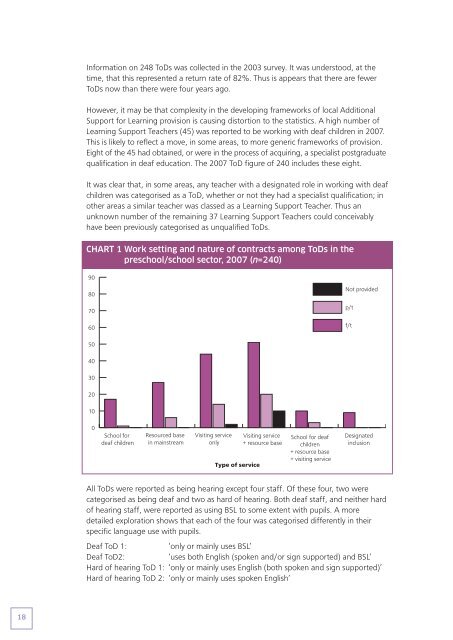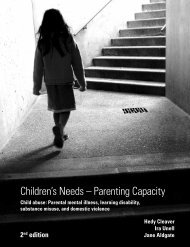British Sign Language and Linguistic Access Working Group ...
British Sign Language and Linguistic Access Working Group ...
British Sign Language and Linguistic Access Working Group ...
Create successful ePaper yourself
Turn your PDF publications into a flip-book with our unique Google optimized e-Paper software.
Information on 248 ToDs was collected in the 2003 survey. It was understood, at thetime, that this represented a return rate of 82%. Thus is appears that there are fewerToDs now than there were four years ago.However, it may be that complexity in the developing frameworks of local AdditionalSupport for Learning provision is causing distortion to the statistics. A high number ofLearning Support Teachers (45) was reported to be working with deaf children in 2007.This is likely to reflect a move, in some areas, to more generic frameworks of provision.Eight of the 45 had obtained, or were in the process of acquiring, a specialist postgraduatequalification in deaf education. The 2007 ToD figure of 240 includes these eight.It was clear that, in some areas, any teacher with a designated role in working with deafchildren was categorised as a ToD, whether or not they had a specialist qualification; inother areas a similar teacher was classed as a Learning Support Teacher. Thus anunknown number of the remaining 37 Learning Support Teachers could conceivablyhave been previously categorised as unqualified ToDs.CHART 1 Work setting <strong>and</strong> nature of contracts among ToDs in thepreschool/school sector, 2007 ( =240)90807060Not providedp/tf/t50403020100School fordeaf childrenResourced basein mainstreamVisiting serviceonlyType of serviceVisiting service+ resource baseSchool for deafchildren+ resource base+ visiting serviceDesignatedinclusionAll ToDs were reported as being hearing except four staff. Of these four, two werecategorised as being deaf <strong>and</strong> two as hard of hearing. Both deaf staff, <strong>and</strong> neither hardof hearing staff, were reported as using BSL to some extent with pupils. A moredetailed exploration shows that each of the four was categorised differently in theirspecific language use with pupils.Deaf ToD 1: ‘only or mainly uses BSL’Deaf ToD2:‘uses both English (spoken <strong>and</strong>/or sign supported) <strong>and</strong> BSL’Hard of hearing ToD 1: ‘only or mainly uses English (both spoken <strong>and</strong> sign supported)’Hard of hearing ToD 2: ‘only or mainly uses spoken English’18
















